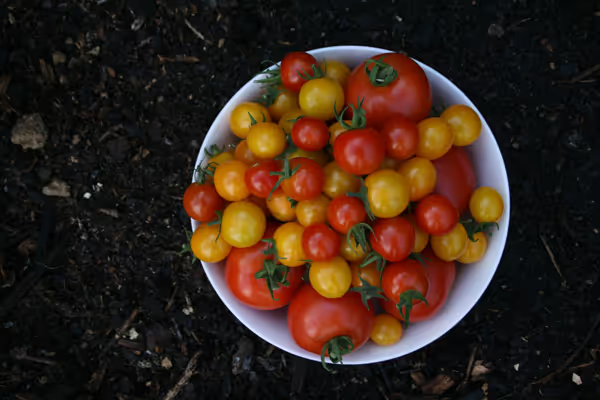Gardening on the coast is unlike gardening anywhere else. Salty soil and air can cut into plants’ moisture supply and frustrate coastal gardeners. Our cool, wet climate also presents challenges—as does the wind. And don’t get me started about the deer! If you’re new to the area (or new to gardening, like I am), you may be wondering what to plant in your garden this year—or if it’s worth planting anything at all.
Have no fear—gardening in coastal Washington can be done! Even a novice like myself can yield a decent crop of zucchinis, strawberries, sweet peas, and many other fruits and veggies without much effort.
This summer, I’ve set my sights a little higher; I’m growing tomatoes. Here are 5 tips for growing tomatoes in coastal Washington.
- Be patient—don’t plant tomatoes too early. Tomato plants need warm, dry weather to thrive. Frost can kill your plants, and they need warmth in order for fruit to ripen.
- If planting from seed, start your plants indoors about six to eight weeks before you plan to bring them outdoors.
- Tomatoes perform the best when the air temperature is between 65 and 85 degrees during the day and doesn’t drop below 55 degrees at night. In late-May to mid-June, once temperatures have warmed and the threat of frost has passed, it will be time to plant your tomatoes (or time to "harden off" your seedlings and begin the process of replanting them outdoors, if you started them from seed).
- Think small. Smaller, salad-type tomatoes like Sungold, Oregon Spring, Early Girl, and others tend to do best in coastal gardens. Larger, beefsteak varieties take too long to mature and likely won’t be ready to harvest before temperatures begin to cool.
- “Determinate tomatoes” grow best in our cool and wet coastal climate, compared to “indeterminate tomatoes.” Determinate tomatoes stop growing once they reach a certain height and tend to yield one crop all at once, while fruit from indeterminate tomatoes ripens over time. Plus, determinate tomatoes tend to be more compact and bushier—and more likely to retain heat—than indeterminate tomatoes, which grow on vines.
- Look out for pests (and deer). Many pests are fond of tomatoes. (And can you blame them?) Protect starts by placing a tinfoil “fence” around plants. Watch for aphids and whiteflies during the summer, especially if you are growing your tomatoes in a greenhouse.
- Keep them warm. Coastal gardeners should take care to keep tomato plants warm, dry, and sheltered from cold coastal winds and fog.
- A few days before you plant your tomatoes, cover the soil in clear plastic to get capture heat. Let your plants sit indoors for a few days before bringing them outside. Then, dig a deep hole. Remove the leaves from the bottom half of your plant and bury part of the stem—this will allow the plant to grow a bigger root system so it will be better able to support more fruit.
- Planting your tomatoes in large containers will help conceal heat. Be sure to use a top quality potting soil (look for soil containing coco coir, which helps improve water retention—fully grown tomatoes plants consume a lot of water while fruit ripens).
- Plant your tomatoes in the warmest, sunniest spot in your garden. A south-facing side of your house can provide reflected heat. Tomato plants need overhead protection from coastal fog and moisture is needed; wet foliage is prone to blight, which can kill your tomato plants.
- Don’t forget to water (from below). While foliage needs to be kept dry, your tomato plants still need to be watered regularly, especially during their fruiting period. Don’t let your plants wilt. Water-stressed plants are more susceptible to disease. Wilting and then overwatering can also cause blossoms’ ends to rot. Water your tomato plants on a regular basis and from below to avoid getting the foliage wet.
Sources
Binetti, Marianne. “Five Secrets for Growing Tasty Tomatoes in Western Washington.” Federal Way Mirror. https://www.federalwaymirror.com/life/five-secrets-for-growing-tasty-tomatoes-in-western-washington/. Accessed 3 April 2022.
“Clallam County Master Gardeners: Tips for Growing Tomatoes in the Pacific Northwest.” Sequim Gazette. https://www.sequimgazette.com/life/get-it-growing-tips-for-growing-tomatoes-in-the-pacific-northwest/. Accessed 2 April 2022.
“How to Grow the Best Tomatoes in Oregon, Washington, & BC.” My Northwest Garden. https://mynorthwestgarden.com/home/tomatoes. Accessed 3 April 2022.
Huppin, Shannon. “What Edibles Grow Best in My Pacific Northwest Garden?” Greenwood Hardware. http://greenwoodhardware.com/edibles-grow-best-pacific-northwest-garden/. Accessed 3 April 2022.
Kramer, Terry. “Tomatoes can be grown on the coast.” Times Standard. https://www.times-standard.com/2015/05/27/north-coast-gardening-tomatoes-can-be-grown-on-the-coast/. Accessed 3 April 2022.
Rhoades, Heather. “Planting Tomato Seeds - How to Start Tomato Plants from Seed.” Gardening Know How. https://www.gardeningknowhow.com/edible/vegetables/tomato/growing-tomatoes-from-seed.htm. Accessed 2 April 2022.
Photo:Phillip Larking on Unsplash
© Holly Duffy, April 2022


